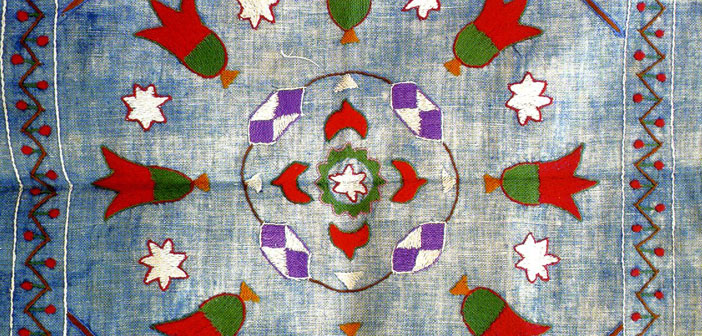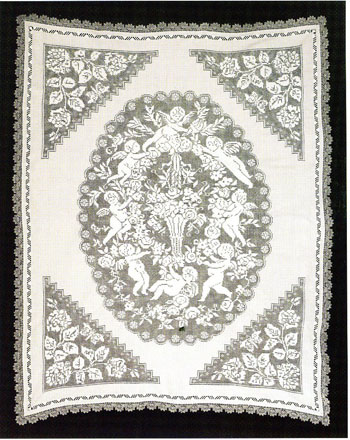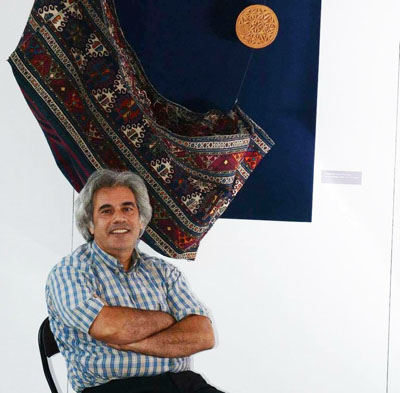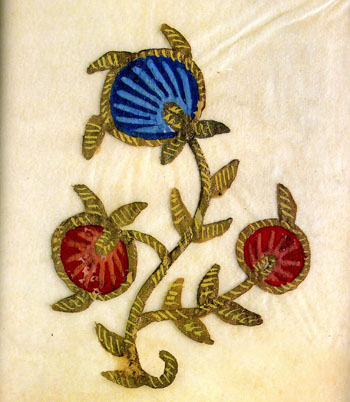‘Antep, Urfa ve Maraş iğne işleri, Ermeni kültürünün bir bütün olduğunu gösteriyor”


Ressam ve araştırmacı Hrazdan Tokmajian, Halep’te yaşadığı yıllarda resim öğretmenliğinin yanı sıra, Maraş, Urfa ve Antepli Ermeni kadınların iğne işleri üzerine de uzun süren araştırmalar yapmış. Tokmajian, bu araştırmaları, Halep’te bulunan Ermeni derneklerinin işbirliğinde, her bir şehir için ayrı ayrı olmak üzere, Ermenice ve İngilizce olarak kitaplaştırdı. Çeşitli evlerden ve müzelerdeki koleksiyonlardan toplanan iğne işi örneklerinin genişçe yer aldığı, yazışmalar ve belgelerle desteklenen, bölgelerde bulunan Ermeni hanelerin, kiliselerin, okulların sıralandığı bu ansiklopedik eserler, Maraşlı, Urfalı, Antepli Ermenilerin kültürel mirası olan iğne işine ışık tutuyor.
Tokmajian’la resme başladığı yıllardan Halep’e uzanıyor; Soykırım’dan sağ kurtularak Halep’e ulaşmış Maraşlı, Urfalı ve Antepli kadınların beraberlerinde getirebildikleri iğne işlerine, üç şehrin nakışları arasındaki farka, 100 yıl içinde gösterdikleri değişimlere, anneden kıza öğretilen ve günümüze ulaşan sanata bakıyoruz.
Öncelikle sizi ressam kimliğinizle tanıyabilir miyiz?
Gümrü’de doğdum. Ermenistan’ın ünlü ressamlarından amcam Tigran Tokmajian, Gümrü’de bizi ziyarete geldiğinde, ‘Ne istersen söyle, çizeyim’ derdi. Dilediğim her şeyin birkaç dakika içinde kâğıt üzerinde olması bana büyüleyici gelirdi. Amcamı örnek alarak, küçük yaştan itibaren ressam olmak istiyordum. Babam botanik uzmanıydı, onu üzmemek için hem ressam hem botanikçi olacağımı söylerdim. On beş yaşındayken ailece Yerevan’a taşındık. Dört yıl, Yerevan’da bulunan Panos Terlemezyan Güzel Sanatlar Okulu’nda, ardından beş yıl üniversitede resim eğitimi aldım. Suriye, Lübnan ve Ermenistan’da birçok sergi düzenledim.
Aile tarihçeniz nereye kadar uzanıyor?
Baba tarafım Erzurumlu. Ailem dökmecilikle uğraşmış. 1828-1830 arasında Erzurum’dan Rusya’ya göç olduğunda, ailem Ermenistan’a geliyor ve zanaatlerini Gümrü’ye taşıyorlar. Ancak, Sovyet döneminde her şey fabrikalarda yapılıyordu veya ithal ediliyordu. Ermenistan’da üretim yoktu. Bir zanaatkârın kendi dükkânının olması yaygın değildi. Büyükbabam ve kardeşleri İkinci Dünya Savaşı’na kadar zor da olsa dökmecilikle uğraşmışlar fakat sonra mesleklerine devam edememişler.

Yerevan’dan Halep’ gitmeye nasıl karar verdiniz? Orada geçirdiğiniz yılları anlatır mısınız?
Üniversiteyi bitirdikten sonra üç yıl Yerevan’a yakın bir köyde resim öğretmenliği, daha sonra bir tiyatronun tasarım işlerini yaptım. 1990’ların başında Ermenistan’ın hali acıklıydı. 1992’de, Halep’teki AGBU’ya (Ermeni Hayırseverler Derneği) bağlı Martiros Saryan Akademisi’nden on yıllığına öğretmenlik yapmak üzere davet aldım. Halep’e vardıktan dört ay sonra eşim ve çocuklarımı da yanıma çağırdım. On yıl diye başladık, 23 yıl orada kaldık. İlk birkaç yıl zordu. Sovyetlerden geliyordum. Sadece ülke değil, insanlar da farklıydı. Ancak kısa sürede alıştım. Yaşadığımız mahallede herkes Ermeniydi. Gittiğim manav, alışveriş yaptığım bakkal, ayakkabı ve giysi dükkânlarının sahipleri Ermeniydi. Bugün hâlâ Arapçam zayıftır. Oradan ev almadık, bir gün Ermenistan’a döneceğimizi düşünüyorduk. Ancak buna savaşın neden olacağını bilmiyorduk. Uzun süre direndim ama kalmak için bir sebep kalmadı. Halep’ten geçtiğimiz Mayıs ayında acıyla ayrıldım. Ermenistan’a vardığımda, vatanıma döndüğümü hissediyordum. Öte yandan Ermenistan da değişmişti, çoğu arkadaşım Rusya’ya ve başka ülkelere göçmüşlerdi.
Gümrülü bir Ermeni olarak Halepli Ermenilerle kurduğunuz ilişkileriniz nasıldı?
Gümrülü olmak pozitif bir algı yaratıyordu. Gümrü’de konuşulan aksan Batı Ermenicesine yakın olduğundan Halepli Ermenilerle birbirimizi daha rahat anlıyorduk. Ermenistan’ın ikinci şehri Gümrü, geleneklerini koruyan ve sanat üreten bir şehir. Halep de, Suriye’nin Şam’dan sonraki ikinci şehri ve Gümrü’yle benzer özelliklere sahip. Halep’teki Ermeniler geleneklerine bağlıydı, sanata önem verirdi. Bir ülkenin ikinci şehrinden, başka bir ülkenin ikinci şehrine gittim.
Halep’in kaybı sizin için ne ifade ediyor?
Halep, kaybettiğimiz Batı Ermenistan’ın somut son parçasıydı. Toprak bizim değildi ama üstünde Kilikya’dan göçmüş Ermeniler yaşardı. Halep yıkılınca dünya için Suriye’nin ekonomi bakımından güçlü şehri yıkılmış oldu. Ermeniler içinse, Batı Ermenilerinin yaşattığı gelenekler, devam ettirdikleri üretim yerle bir oldu. Bir gün anılarımı yazarsam, ‘Batı Ermenilerini kendi yaşayışları içinde gördüm’ diyebilirim. Büyük şehirlerde ve ülkelerde özelliklerini daha kolay kaybediyorsun. Örneğin, Şam’da veya Lübnan’da hayat hızlı, ancak başarılıysan ayaklarının üzerinde durabilirsin, paran yoksa çocuğunu Ermeni okuluna gönderemeyebilirsin. Halep’te ise her şeyin bir yolu bulunur. Halepli Ermeniler arasındaki dayanışma çok güçlüydü. Ermenice ölmüş de canlanması gereken bir dil değildi. Edebiyat dergileri ve ders kitapları yayımlanırdı. Dergilerde, Diasporalı ünlü yazarların yanı sıra, okullarda iyi yazan öğrencilere de yer verilir, böylece yazar ve şair yeni bir nesil yetişirdi. Halepli Ermenilerin üretimi çevre ülkelere de yarar sağladı.
Peki iğne işi üzerine çalışmaya nasıl başladınız? Örneğin, serinin ilk kitabı ‘Maraş İğne İşi’ nasıl ortaya çıktı?
2007’de, Halep’teki ‘Maraşlı Ermeniler Derneği’ ile kültürel üretimi hatırlatmak ve güçlendirmek istedik. 40-50 yıl önce Suriye’nin en güçlü futbol takımı Maraşlı Ermenilerin takımıydı. Futbolcularla söyleşiler yapıp, bunları bir kitapta topladık. Maraşlılar iğne işleriyle, nakışlarıyla çok övünüyorlardı. ‘Maraş iğne işini neden kitaplaştırmıyorsunuz?’ diye bir fikir ortaya attım. Kilikyalı Ermeni kadınların iğne işleri sanatsal açıdan zengin ve çok amaçlı. Maraş’ta iki çeşit iğne işine rastlıyoruz. Halk arasında ‘atlaslama’ adı verilen düz örgü (Ermenicesiyle ‘hartagar’), diğeri ‘irga’ adıyla bilinen gizli örgü (Ermenicesiyle ‘kağdnagar’). Atlaslama diğer vilayetlerde de görülürken, gizli örgü yalnızca Maraş bölgesinde yapılıyor. Hâkim olan koyu mavi ve kırmızı tonlar, Ortaçağ geleneğinin bir devamı olarak okunabilir. Haçı andıran, dört elementi simgeleyen motifler işleniyor. Maraş, pamuk işlemede, özellikle pamuk dokuma ve boyama konusunda önemli bir merkez olmuş. Nakış için gerekli olan kumaş ve ipliğin çoğu yerel pamuktan sağlanıyor. Duvar ve yer halılarının yanı sıra, gecelikten masa örtüsüne kadar her şey, özellikle pamuklu kumaş ile yapılıyor. Halep’te, kadınların Maraş’tan getirdikleri parçalar, rengiyle ve materyaliyle geleneksel işlerdi. Eskiden çeyizde, gelin kullanmasa bile muhakkak terlik, gecelik, çarşaf, yatak örtüsü olurdu. Halep’e geldiklerinde iğne işi bazı değişimler geçiriyor. Kullanılan kumaş ve iplik, işledikleri nakış motifleri değişiyor.

Bütün bu çalışma sırasında hangi kaynaklardan yararlandınız?
Bu işi yapmaya karar verdiğimde, Ermenilerin iğne işçiliğine dair yazılan ne varsa okumak istedim. Saryan Akademisi’nin kütüphanesi çok zengindi. Maraş hakkında yazılan kitapları okudum. Başlıca kaynağımsa Maraşlılar oldu. Kitaptaki el işlerinin çoğu Lübnan, Halep ve Şam’daki Ermeni kadınların yaptıkları işler. Evlerine gittim, hikâyelerini dinledim, Maraş’tan getirebildikleri ve daha sonra Halep’te ürettikleri işlerini fotoğrafladım. Yanı sıra, kitaba müzelerdeki koleksiyonlardan aldığım örnekleri koydum. Ayrıca, tüm kitaplar için, Lübnan’a, Amerika’ya haber salındı, dergilere ilan verildi. Evinde Antep, Urfa, Maraş iğne işi olanlar, el işlerini fotoğraflayıp gönderdiler.
Ardından Urfa iğne işi kitabınız geldi. Burada nasıl bir yol izlediniz?
Maraş kitabının hazırlanış süresinden haberdar olan Episkopos Şahan Sırpazan, Urfa üzerine de çalışmamı istediğini söyledi. Urfalı kadınların iğne işlerinin ilk bölümünü yayımladık, ikincisi üzerinde hâlâ çalışıyorum. Urfa işlerine baktığımızda, çiçek desenlerinin hâkim olduğunu görüyoruz. İğne işleri, basit ve karmaşık desenleriyle Ortaçağ resminin ruhunu yansıtıyor. İşlenen parçada ince dallarla ve yapraklarla süslenmiş bir ya da iki çiçeğe rastlıyoruz. Bükülmüş dal, hem Doğu hem Batı sanatında rastlanan ortak bir motif.
Antep’ten Halep’e getirilen iğne işlerinde öne çıkan özellikler nelerdir?
Antep için örnek toplamak en kolayıydı. Çok fazla kaynak vardı. Diğer bölgelere nazaran Soykırım’dan daha az etkilendikleri için, Antepliler; Halep’e eski fotoğrafları, tapuları, belgeleri, bohçaları alıp ulaşabildiler. Halep’teki her Ermeninin evinde mutlaka iğne işi bulunurdu. ‘Antep işi’nin temel özellikleri saten dikiş ve dantel iplik işi. İşlenmiş iplik işleri antik zamandan beri, Ermenilerin yaşadığı bölgelerde yapılıyor. Benzer formların simetrik bir şekilde, uyum içinde işlenmesi, ‘Antep işi’ni eşsiz kılan özelliklerden.
Antep dantel işlerinde genellikle sekiz köşegenli yıldız görürüz. Bu Sırpazan’ın işaretidir. Zeugma, Komagene Ermeni İmparatorluğu’nun şehirlerinden biriydi. Orada hâlâ arkeologlar kazı yapıyor. İ.S. ilk yüzyıldan kalma bir mozaik buldular. Bu mozaiği Antep’te açılan yeni bir müzede görmüştüm. Sekiz köşegenli yıldız vardı mozaiğin üzerinde. Van işlerinde de aynı motife rastlıyoruz. Taniel Varujan, 1914’te ‘Navasart’ adlı bir sanat dergisi çıkarıyordu. Orada yer alan bir yazıda, Ermeni Kralı Dikran Medz’in (Büyük Dikran) parası üzerinde yer alan kral tacında sekiz köşegenli yıldızdan bahsediliyordu. Demek istediğim, kültürün bir bütün olduğu. Tarihi Hıristiyanlıktan önce ve sonra diye ayırırız, ancak kültürün birbirine zincirlendiğini görürüz.
Bu şehirlerin nakışları arasındaki temel farklar ve yüz yıl içinde geçirdikleri değişim hakkında neler söylemek istersiniz?
Maraşlı Ermeniler Antepli Ermenilere göre daha taşralı bir toplum. Antep ise şehir olarak daha gelişmiş. Antep’te Amerikan Koleji var, dolayısıyla yurtdışıyla etkileşim daha güçlü. Kadınların nakışları daha ‘ince.’ Biraz da abartı var. Her şeyin üzerinde nakış var. Mendili bile ince ince işlemişler. Gecelik de, geceliğin konulacağı çeyiz bohçası da işli. Güvenli hayatın titizliği diyebiliriz. Maraş’ta ise, kullanılacak şey üzerinde çalışıyorlar, öncelikle dayanıklı olmasına önem veriyorlar.
Antep’in iğne işlerinin yapıldığı tarihler daha kesin. Diğer iller içinse yaklaşık tarihler veriliyor. Evdeki çeyize ve kadının evlilik tarihine bakılıyor. Ancak, çeyiz, anneden kıza da kalmış olabilir. 1894-1896 yıllarındaki Hamidiye katliamlarından sonra, bölgeye gelen yabancı misyonerler kayıt tuttukları için, bu tarihten sonraki el işlerine dair daha kesin bilgiler vermek mümkün. Antep’te bulunan Amerikan misyoner Fanny Shepard, Ermeni kadınların iğne işleri yurtdışı pazarında satılsın diye, Batı’dan modeller getiriyor. Bu nedenle 1915’e kadar da motiflerde değişiklik oluyor. Antep’te genelde dantel işi yaygın ve dantelin ortasına sekiz köşegenli yıldız işleniyor. Batı etkisiyle, bu yıldızın yerini melek figürleri alıyor. Urfa’da ise Alman misyonerler var. Onlar, Shepard’ın aksine, gelenekselin korunmasını teşvik ediyorlar. 1915’ten sonra yaşam yeri değiştiği için doğal olarak nakışlar da değişiyor. Maraş’ta çoğunlukla pamuk üzerine çalışılırken, Halep’te yaşayan Maraşlı kadınlar 1930’larda kadife üzerine de işlemeye başlıyorlar. Eski el işlerinin belli ölçüleri var. Kırmızıyı çıkarıp yerine turuncu koyamazsın. Yeni parçalarda ise isteyen dilediği rengi kullanabiliyor. Eskilerin yaptığı işlerde, kullandıkları renklerde bir anlam var. Gelenekler yavaş yavaş zayıflıyor. Şimdi biz Ermenistan’da dikiş okulları açıp sıfırdan iğne işi öğretiyoruz. Ancak, iğne işi anneden kıza geçen bir zanaat. Motifi de rengi de anne kızına öğretiyor.

Halep’te iğne işi yapan yaklaşık kaç kişi kalmıştı?
Halep’te son yıllarda el işi yapan birkaç Maraşlı kalmıştı. Onlar da, daha çok hediyelik küçük parçalar çalışırlardı. ‘Bana büyük bir yatak örtüsü yap’ desen yapmazlar. Çünkü onun aylarca uğraşacağı işin ücretini ödeyecek kimse yok. Yaşça büyük olanların gözleri iyi görmüyor artık. Urfalı ve Antepli iğne işi yapanların sayısı da ikiyi geçmezdi. Antep işi daha ince ve zahmetli olduğu için, onun ücreti Maraş işinin üç katı olurdu. İsim yapmış olanlar, sipariş üzerine çalışır, işler elişi dükkânlarında satılır veya senede birkaç kez düzenlenen kermeslerde satışa sunulurdu. Kilis işi adı verilen bir elişi var. Bir rengi diğer rengin üstüne koyar, öyle dikersin. Halep’te eskiden öyle bohçalar yapılırdı. Bohça hamama giderken gerekliydi. Son 30-40 sene hamama gitmez oldu kimse.
Maraş, Antep ve Urfa’yı ziyaret ettiniz mi?
Urfa’yı gezecek çok vaktim olmadı. Maraş’ta iğne işi yapan bir dükkâna gittim. Ellerindeki işleri çıkarıp gösteriler. Birkaç kez Antep’e gittim. İlk ziyaretim arkadaşımın işi dolayısıyla oldu. Bir günlük bir geziydi. Asdvadzadzin Kilisesi’nin etrafında dolaştık. Çok etkilendim. Türkiye’nin birçok şehrinde izi kalmasın diye Ermenilerden kalan her şeye zarar veriliyor. Ama Antep’te öyle değildi. Nazaretyanlar’ın evinde pencerelerdeki Ermenice yazılar duruyordu. Müslümanlaştırılmış Ermenilerle karşılaştık. Bakırcılar Çarşısı’nda ustalarla sohbetimizde, bize Ermeni bakır ustalarının isimlerini saydılar, ailelerinden kalan olup olmadığını sordular. İşi Ermeni ustalardan öğrendiklerini söylüyorlardı.
Bu kitaplar özellikle kimler için önem taşıyor?
Doğu Ermenilerinden bazıları belki Maraş’ın nerede olduğunu bile bilmezler. Kitaplar, Ermeni halkının ve kültürünün bir bütün olduğunu anlamak için önemli. Toplumun kültürünü, topluma geri vermek için önemli. Belli gelenekler zaman içinde kaybolmuş. En azından bugüne ulaşmış işler ortaya çıkarılmalı. Ermeni kadınlar hâlâ iğne işi yapmaya devam ediyor. Urfa kitabı yayımlandığında, tasarımcı bir arkadaşım Urfa nakışını giysilerine taşıdı ve bir defile yaptı. Kitaptan yararlanmaları benim için çok değerli. Yerevan’ı ziyaret eden bir Antepli kitabı istedi, aldı ve Antep’e götürdü.
Kitapları hazırlama süreçlerinde nasıl zorluklarla karşılaştınız?
Üç kitabın da en önemli yanı, iğne işlerinin bilimsel analizi. Maraş iğne işleri renkli resme daha yakın olduğu için işlerin analizini yapmak daha kolaydı. Antep işlerine baktığınızda, çoğu dantel, beyaz iş görürsünüz, dolayısıyla motiflerin değerlendirmesi daha zordur. Urfalı kadınların nakışlarının da analiz kısmı zaman aldığı için, kitabın ikinci bölümü üzerinde hâlâ çalışıyorum. Örneğin, çiçek demetleri işlemişler, ancak geleneksel iğne işinde buna pek rastlanmıyor. Bu değişim ve etkileşimleri ortaya çıkarmak önemli.

‘Halep’te bazı bölgeler küçük Ermenistan gibiydi…’
Tarih boyunca göçler olsa da Halep’te yerleşik bir Ermeni nüfusu ve kültürü hep var olmuş. 500 yıllık Karasun Manuk Kilisesi’ne bakın. Öte yandan, Soykırım sonrası Ermeni nüfusu artıyor. 1915’ten sonra Halep’e gelen Ermenilerin çoğunluğu Kilikya bölgesinden. Antep, Halep’e en fazla 150 kilometre uzakta. Antepli Ermeniler, eşyalarını sırtlayıp gelmeyi başarmışlardı. Bu nedenle, Antep’le ilgili yaptığım araştırmada kaynak sıkıntısı çekmedim. Evlerde, 19. yüzyıldan kalma çok fazla el işi vardı. Maraş, Antep’e göre Soykırım’dan daha fazla etkilenmiş bir yerdi. Onların kurtardıkları eşyalar görece olarak daha azdı. Çok fazla Urfalı da yaşıyordu Halep’te. Urfa, daha doğuda olmasına rağmen, bir süre Fransa’nın kontrolünde bulunan köylerde yaşayan Urfalı Ermeniler, 15-20 yıl sonra şehre gelmek istediler ve Halep’e göç ettiler. 1946’ya kadar Halep’te bazı bölgeler küçük Ermenistan gibiydi.


